
Background information
My new cannabis grow setup is an expensive dream
by Martin Jud

Cannabis flowers have a light fruity-sweet scent. However, a tent full of flowers will be pungent. To keep my apartment and the stairwell I share with my neighbours fresh, I use a duct fan and an activated carbon filter.
When the farmer next to your house fertilises his field, it stinks. The problem isn’t only the disgusting smell itself, but also its intensity. At least on this second point, manure and the smell in my new cannabis tent will produce are no different. After all, the terpenes produced in the resin glands of the hemp plant are so pungent that a single flowering cannabis bud is enough to incur the wrath of my neighbours.
An exhaust air system with activated carbon filters can prevent unpleasant odours. In this article, I’ll explain how big it should be and how powerful a tube fan you should get. I bought «oversized» products for my small tent and go against the norm by using them outside the grow box.
This is the last post in my miniseries. As a bonus, you’ll find out at the end of this article how many watts the individual components of my growth setup draw and how high the electricity costs are over 110 days of plant cultivation were. You can find the previous three articles here:
There are two reasons for installing an exhaust air system:
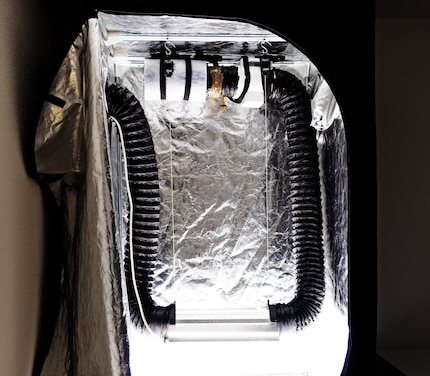
Typically, you install an exhaust air system at the top of the grow box in the following order: Active carbon filter > Ventilation hose > Pipe fan > Ventilation hose to the outside.
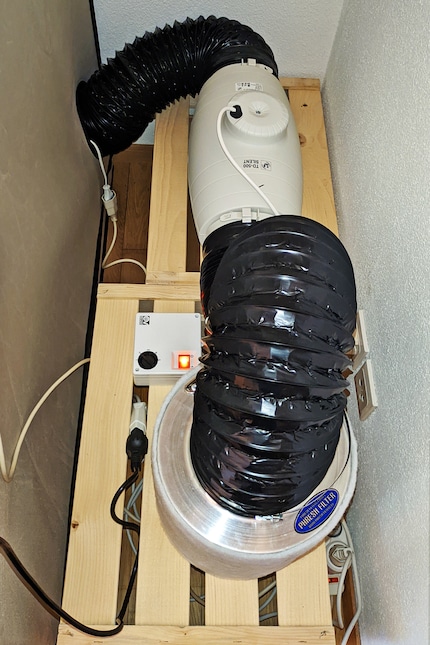
If the components are located outside the tent, you’ll have more space for tall plants. Here, the order of components is reversed: Pre-filter box in the tent > Ventilation hose to the outside > Tube fan > Ventilation hose > Activated carbon filter.
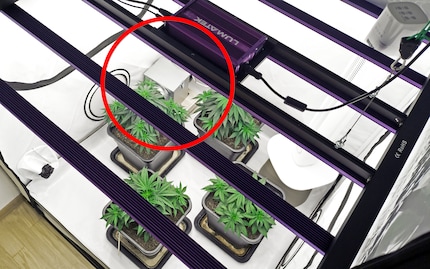
With a system inside the tent, a felt cover on the activated carbon filter removes dust out of the air. If the tube fan and the rest are outside, they suck air into the hose unfiltered. Unless you use an additional pre-filter box, as I do, in the back left corner of the tent.
If you’re wondering whether extracting air from the bottom of the tent causes heat to build up at the top: yes. But only if you don’t do anything about it. In my article on successful indoor cannabis growth, you can find out how to tackle this.
To provide the plants with sufficient fresh air and keep the temperature and humidity low, you need a suitably powerful tube fan and the appropriate activated carbon filter. You should also ventilate the room in which your grow box is located well. In addition to a tiltable window, or even better a skylight in the same room, a door can also help with regulation.
To choose the right fan, you need to know how much air it should move over what period of time – i.e. how many cubic metres per hour (m³/h). As a rule of thumb, all air in the grow box should be exchanged after five minutes at the latest during the vegetation phase. During the flowering phase, this should go down to two minutes max.
There are ventilation calculators online to save you from tedious maths. Go here or here (links in German). The problem with these calculators, however, is that they calculate a result based on the wattage of a sodium vapour lamp, among other things. If you have an LED lamp, the result will be wrong. Although these calculators ask whether you use cool tubes or LED lamps, this only refers to the temperature in the tent and not to the effectiveness of the light.
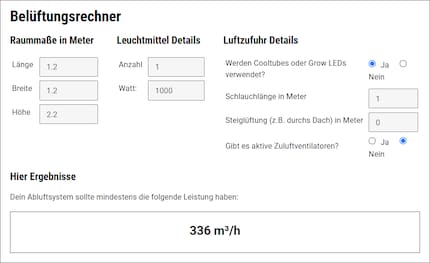
The solution: when specifying wattage, it helps to know that a sodium vapour lamp (NDL) with 1,000 watts achieves an efficiency of around 2.1 µmol/J. My LED plant lamp is much more effective with 2.9 µmol/J at 600 watts. However, I dim it down to 75 per cent during flowering, which in turn corresponds to 2.175 µmol/year. So about the same as a 1,000-watt NDL. I therefore enter 1,000 watts in the calculator. The remaining details are filled in by the dimensions of the other components. I use a tube fan and activated carbon filter with an output of 336 m³/h.
If I want to convey around 300 m³/h, a relatively inexpensive tube fan is generally sufficient. The Garden HighPro GHP Profan at 66 francs in our store would be an almost perfect match. It’s made for 125 mm hoses and can handle up to 280 m³/h. The Siku VKMz 125 Radial for 146 francs with 330 m³/h would be just the right fit. For the activated carbon filter, I could go for a Rhino Pro 425 m³/h 125 mm, which currently costs 136 francs. I can recommend the Rhino brand, as I’ve used it so far and have been very satisfied.
In the end, I bought even stronger components. The reason? I want a setup that’s as quiet as possible and hopefully lasts a long time. The following factors make a quieter tent:
Compared to my old grow setup, I chose to switch from ventilation hoses with a diameter of 125 millimetres to those with a diameter of 160 millimetres for the new one. I actually wanted to go for 200 mm hoses, but the larger the diameter, the higher the price of other components.
After hours of research, I chose a quiet model for the raw fan but it wasalso oversized. Still, the TD-500 Silent (150-160 mm) tube fan from Soler&Palau costs CHF 315 and, at 580 m³/h, goes above and beyond the 336 m³/h target:
At full blast, I could even use it on the set of a hairspray commercial. Or as bellows for a fire. In my case, a step transformer throttles it down.
For the activated carbon filter, I actually wanted to go for this Rhino Pro filter, but it wasn’t available at the time. The Phresh activated carbon filter chosen as a replacement hasn’t disappointed me so far:
I don’t see the fact that it’s designed for 600 m³ per hour as a disadvantage. It should actually last longer as a result. I hope to achieve around eight grow cycles with the Phresh P600. If that works out, I wouldn’t have to buy a new one for another eight years.
It should be noted that the Soler&Palau tube fan comes without a power cable and without a step transformer. My transformer labelled Vortice SCNR5-CA (5 levels – 110, 125, 150, 180, 220 volts) was hard to get and cost 81 francs. Unfortunately, this transformer isn’t currently available in our store. Only a sibling model with the designation SCNR5 (without the «-CA»), which isn’t as suitable. This alternative provides too little power at the first stage to start the tube fan. However, if I were to start it at level two, I could probably go back to level one later to use it at a very low throttle.
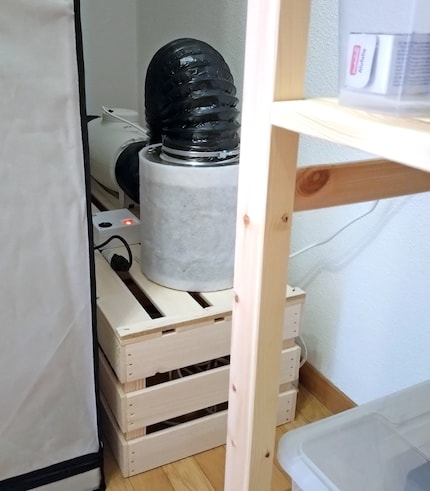
The entire exhaust air system including the power cable, pre-filter box, 160 mm ventilation hose and three hose clamps cost me 828.60 francs. In terms of power consumption, the tube fan is fine. Although my new exhaust air system is quieter than my old one, I have to admit, the difference isn’t particularly astounding.
Nevertheless, a powerful fan and activated carbon filter somehow work better with the equally «oversized» LED lamp. What’s more, the exhaust air components account for less than a third of the total cost of the setup, which is CHF 2627.40. I’m more than satisfied as a result.
In the first article of this series, I dreamed of soon harvesting 3,600 francs worth of CBD weed. So far, it looks like this’ll work out. If this does happen, the costs of the setup would be amortised with just one grow cycle. However, on top ofmy initial budget, there are also secondary costs. In addition to the seeds, soil, water and fertiliser, electricity also costs money. But how much exactly? I checked the individual components with an ammeter. My setup draws 548.5 watts for 12 hours per day when the plants are flowering and 69.9 watts for the remaining 12 hours.
The following list shows how many kilowatt hours of electricity I need for my current grow cycle based on my measurement results:
According to the Swiss Federal Electricity Commission (article in German), the electricity price for a typical household will be 32.14 cents per kilowatt hour in 2024 (up 18 per cent on 2023). This means that a grow will cost around 242 francs over 110 days. That’s CHF 2.20 per day and CHF 66 per month. When I think about the high cost of finished cannabis products, these electricity costs look fine to me.
I hope you enjoyed my short series on cannabis. Goodbye for now, at least until I’ve got more to report. With my PAX vapouriser in hand and fragrant flowers at my side, I’ll now return to less controversial topics from the tech sector.
Header image: Martin Jud
I find my muse in everything. When I don’t, I draw inspiration from daydreaming. After all, if you dream, you don’t sleep through life.
Interesting facts about products, behind-the-scenes looks at manufacturers and deep-dives on interesting people.
Show all
Background information
by Martin Jud

Background information
by Martin Jud

Background information
by Darina Schweizer